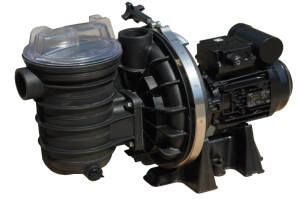 How much electricity does my pool pump use?
How much electricity does my pool pump use?
In homes with pools, the pool pump is, on average, the 2nd most power hungry appliance after the air conditioner. An inefficient pool pump might use around 2,500 KWh per year, maybe more for bigger pools. To give some perspective: the average u.s. residential utility customer uses somewhere around 11,000 KWh per year, in total.
Adjust or upgrade?
If you have a single speed pump, you can try reducing its hours per day to save energy. But regardless, it won’t be as efficient as a variable speed pump (see below). Currently, no single speed pumps meet Energy Star standards.
Variable speed pumps
Variable speed pumps are the most efficient option. They can be programmed to adjust flow rates depending on what other devices are in use, and other factors. Variable pumps are the most expensive, but through lower energy use and rebate programs, they can easily pay for themselves. They require a fair bit of knowledge to install and program.
Choosing the right pump still depends on your pool and its filtration system. Your pool’s size, the maximum flow rate of your pipes and filters, and the resulting turnover time (how long it takes to cycle out all the water in the pool), are all relevant to your pump’s desired power. The math gets tricky, especially when there are multiple lines.
To start with, find your filter’s maximum flow rate. An overpowered pump may exceed this, causing the water to not be filtered properly. Furthermore, an overpowered pump will use more electricity, and can be noisy! Just remember that more power is not always better. Slow pace, low friction, and intelligent programming are key to efficiency.
Interestingly, the technology of variable speed drives (VSD), or variable frequency drives (VFD) goes far beyond the swimming pool application. Apparently, a large percentage of worldwide power consumption goes to systems with fixed-speed motors pushing pumps, fans, and compressors. VFDs, in the right applications, can be a big efficiency upgrade.
2-speed pumps are NOT variable speed pumps
Some manufacturers have come up with a product that simply uses 2 fixed speed pumps, of different speeds. These are generally not reprogrammable, not cycled intelligently, and are powered by an inefficient induction motor. More importantly, neither of the speeds are likely to be the right speed for the pool. If you’re going to go fixed speed, you might as well go single speed, at the consistent, correct low flow rate and hours per day.
Incentives beyond reducing your bill
The PGE Energy Upgrade CA program is now starting to offer rebates for pool pumps, in connection with other energy upgrade work being done on the home. Here is the process:
1) Have an approved Home Performance company perform an energy audit testing of the home. They must be a participating contractor in the Energy Upgrade CA program.
2) The contractor will create a software energy model of the home that qualifies a homeowner for the rebate. This model will also show what the rebate amount will be for various upgrades performed on the home.
3) Perform the efficient pool pump install and the other upgrades to the home (insulation, air sealing, high performance heating/cooling).
4) The contractor will then process the remaining paperwork and you will receive a check in the mail 4-6 weeks after the work has been completed.
[dropshadowbox align=”none” effect=”lifted-both” width=”640px” height=”” background_color=”#ffffff” border_width=”1″ border_color=”#dddddd” ]For more information, call (925) 363-4498 or e-mail info@epbuilders.com to speak to a technician, or schedule an energy audit.[/dropshadowbox]

[…] 8. Hot water Turn your water heater down to the warm setting (120 F). Save energy, lower heat gain, and avoid scalding your hands! Water heating can account for a large portion of homeowners’ base load energy use, and this can usually be reduced easily. Find out more about “on demand” efficient water heating recirculation systems (not to be confused with “on demand” tankless water heaters). Also, if you have a pool, reducing your pool pump’s activity per day can save a ton of energy. The best way to do this is to install a variable-speed pump. […]